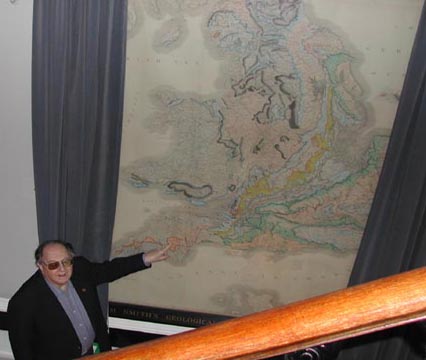I am very sorry to hear about Lisa Rossbacher's frustrating experience on her visit to London, when she tried so gamely and failed so miserably to see the William Smith 1815 geological map of Britain — "The map that changed the world." As Simon Winchester's book states, it is to be seen at the Geological Society of London (not the Geological Survey of Great Britain) at Burlington House in Piccadilly. We at GSL have been welcoming people on visits most weekdays at 3:00 p.m., ever since the book was published in 2001. We are delighted by the new public interest in this unique treasure, and that so many people from all over the world take the trouble to come to Piccadilly — often their first stop after landing at Heathrow — and look us up.
All information about how to visit the map can be found on the Geological Society of London's Web site. At the moment, there is a "hotlink" to the appropriate page on our front page — in the "Update" box. You can also go straight there. This has links to maps and travel directions, as well as instructions about how to make sure that you come on a day when there is either a viewing or a full 40-minute guided tour by the "functionary," who remains.
Ted Nield
Editor of the Geological Society of London Web site
Subeditor, Geoscientist
 I
have read with interest Lisa Rossbacher's column "Searching for The
Map." As a fellow of the Geological Society of London who lives in
the United States, I have for many years visited the society, commonly
once a year, for participation in society meetings, and studies of busts
and pictures of society founders.
I
have read with interest Lisa Rossbacher's column "Searching for The
Map." As a fellow of the Geological Society of London who lives in
the United States, I have for many years visited the society, commonly
once a year, for participation in society meetings, and studies of busts
and pictures of society founders.
Gerald Friedman stabds with William Smith's 1815 "map that changed the world."
The Geological Society's "Map that Changed the World" is not a unique copy. At Imperial College, within walking distance of the Geological Society, is another copy of this same map, once again signed by William Smith and likewise dated Aug. 15, 1815. A curtain does not protect this map, and students see this real map as they arrive and depart from classes. However, you do not have to travel to England to view this map. Last year, Simon Winchester came to Troy, N.Y., for a lecture at Rensselaer Polytechnic Institute. Two copies of the original map were on display: (1) a copy that Union College owns, and (2) a copy that belongs to the Northeastern Science Foundation, associated with the City University of New York. The latter copy was formerly owned by the president of the Royal Society, but — like others — found their way to American geological collections.
Gerald
M. Friedman
Brooklyn, N.Y.
Back to top
Back to Travels in Geology

